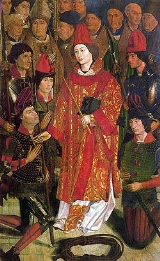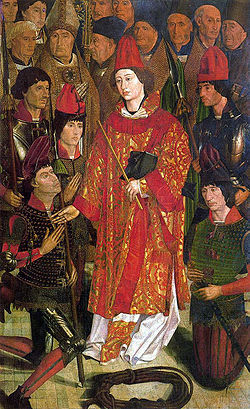
Nuno Gonçalves
Encyclopedia
Nuno Gonçalves was a 15th century Portuguese
artist
credited for the painting
of the paineis de São Vicente de Fora (Saint Vincent Panels
). The panels depict the main elements of Portuguese society
in the 15th century: clergy
, nobility
and common people
. Very little is known of his life, neither his birth or death dates are known; but documents of the time seems to indicate that he was active between 1450 and 1490. The only reference that art historians can use to support his authorship of the Saint Vincent Panels is by Francisco de Holanda
Very little is known of his life, neither his birth or death dates are known; but documents of the time seems to indicate that he was active between 1450 and 1490. The only reference that art historians can use to support his authorship of the Saint Vincent Panels is by Francisco de Holanda
, in the 16th century. It mentions a great work of art made by him that is inferred to be the Panels. It is also speculated that the father of Hugo van der Goes
collaborated in the painting of the panel but there is not concrete proofs. Since their discovery in late 19th century there has been great dispute over the identity of the painter and the characters shown in the Panels. Even the claim that Prince Henry the Navigator appears in the third panel is still under debate. Nevertheless "Saint Vicent Panels" is seen as the highest peak of Portuguese antique art.
The regional museum of Aveiro displays a portrait of Princess Joana, 'the Holy Princess', attributed to Nuno Gonçalves.
He is depicted, among several other historic figures, on the Padrão dos Descobrimentos
(monument of the discoveries) in Belém near Lisbon.
Portugal
Portugal , officially the Portuguese Republic is a country situated in southwestern Europe on the Iberian Peninsula. Portugal is the westernmost country of Europe, and is bordered by the Atlantic Ocean to the West and South and by Spain to the North and East. The Atlantic archipelagos of the...
artist
Artist
An artist is a person engaged in one or more of any of a broad spectrum of activities related to creating art, practicing the arts and/or demonstrating an art. The common usage in both everyday speech and academic discourse is a practitioner in the visual arts only...
credited for the painting
Painting
Painting is the practice of applying paint, pigment, color or other medium to a surface . The application of the medium is commonly applied to the base with a brush but other objects can be used. In art, the term painting describes both the act and the result of the action. However, painting is...
of the paineis de São Vicente de Fora (Saint Vincent Panels
Saint Vincent Panels
The Saint Vincent Panels, or The 'Adoration of Saint Vincent' panels, are a polyptych consisting of six panels that were painted in the 1460s. They are attributed to the Portuguese painter Nuno Gonçalves who was active from 1450 to 1471...
). The panels depict the main elements of Portuguese society
Society
A society, or a human society, is a group of people related to each other through persistent relations, or a large social grouping sharing the same geographical or virtual territory, subject to the same political authority and dominant cultural expectations...
in the 15th century: clergy
Clergy
Clergy is the generic term used to describe the formal religious leadership within a given religion. A clergyman, churchman or cleric is a member of the clergy, especially one who is a priest, preacher, pastor, or other religious professional....
, nobility
Nobility
Nobility is a social class which possesses more acknowledged privileges or eminence than members of most other classes in a society, membership therein typically being hereditary. The privileges associated with nobility may constitute substantial advantages over or relative to non-nobles, or may be...
and common people
Person
A person is a human being, or an entity that has certain capacities or attributes strongly associated with being human , for example in a particular moral or legal context...
.

Francisco de Holanda
Francisco de Holanda , was a Portuguese humanist and painter. Considered to be one of the most important figures of the Portuguese Renaissance, he was also an essayist, architect, and historian...
, in the 16th century. It mentions a great work of art made by him that is inferred to be the Panels. It is also speculated that the father of Hugo van der Goes
Hugo van der Goes
Hugo van der Goes was a Flemish painter. He was, along with Jan van Eyck, Rogier van der Weyden, Hans Memling and Gerard David, one of the most important of the Early Netherlandish painters.-Biography:...
collaborated in the painting of the panel but there is not concrete proofs. Since their discovery in late 19th century there has been great dispute over the identity of the painter and the characters shown in the Panels. Even the claim that Prince Henry the Navigator appears in the third panel is still under debate. Nevertheless "Saint Vicent Panels" is seen as the highest peak of Portuguese antique art.
The regional museum of Aveiro displays a portrait of Princess Joana, 'the Holy Princess', attributed to Nuno Gonçalves.
He is depicted, among several other historic figures, on the Padrão dos Descobrimentos
Padrão dos Descobrimentos
Padrão dos Descobrimentos is a monument on the northern margin of the Tagus River estuary, in the civil parish of Santa Maria de Belém, Lisbon...
(monument of the discoveries) in Belém near Lisbon.
Sources
- Paulo Pereira (editor), "História da Arte Portuguesa", Lisbon, Editorial Estampa / Círculo de Leitores, 1996, volume 1.

